

Discussion on this topic has been mainly limited to power system specialists from developed countries.
As a consequence, it is often biased towards liberalised contexts and is narrowly focused on the power
system layer itself. However, a successful transition hinges on collaborative efforts with a global dimension,
requiring deep, active and informed participation from all countries reflecting different socio-political
contexts. A holistic approach is needed that addresses the interactions across the different systemic
layers: power, energy, economy, social and Earth (Figure S-1).

This report aims to fill these gaps by addressing the transition requirements of power system organisational
structures, with a holistic vision and an inclusive approach that is applicable in both liberalised and regulated contexts. For this purpose, the report is structured around two main goals:
1) making the discussion about power system organisational structures and their transition requirements accessible to a wider audience, as well as contextualising it within a systemic vision; and
2) presenting and discussing the transition challenges for power system organisational structures and proposing a way forward that matches the requirements needed for the renewable energy era.
A conceptual shift introduced in the dual procurement approach is to make long-term electricity procurement schemes one of the two main pillars, hence acknowledging that they are here to stay. By separating the LT-RE and ST-Flex procurements, one of the main issues with unlimited scarcity pricing is directly addressed: during a scarcity event, not all generation will be rewarded at the scarcity price; rather only the generation and demand components supplying the required flexibility will be rewarded at this price, thereby minimising the chance of generating windfall profits.

Auctions or direct public investment become the backbone of LT-RE procurement, through long-term procurement mechanisms that address the requirements of CAPEX-intensive technologies. ST-Flex procurement addresses procurement of the flexible resources needed for the reliable operation of a renewable-based power system, and is based on marginal prices, with a granular bidding format. Essential characteristics of the two procurement mechanisms are described in Table ES-1.

A HOLISTIC VISION OF POWER SYSTEM ORGANISATIONAL STRUCTURES IN A TRANSITION CONTEXT
THE NEED AND URGENCY FOR THE ENERGY TRANSITION: ADDRESSING CLIMATE BREAKDOWN
Despite growing evidence of human-caused climate change, global emissions of carbon dioxide (CO2) have continued to grow, increasing 1.5% annually on average during the last decade (Global Carbon Project,2022). The gap between observed emissions and the reductions needed to meet internationally agreed climate objectives is widening (UNEP, 2020). If left unchecked, those emissions could contribute as much as 4-5 degrees Celsius (°C) of planetary warming on average by 2100, causing significant damage to the environment and to socio-economic systems, with consequences for the human populations that depend on them. The year 2020 was one of the warmest on record, and the effects of climate change have become increasingly apparent, with wildfires, droughts, storms and glacial melting intensifying (IPCC 2018, 2014; UNEP, 2020).

Reducing carbon emissions in line with the requirements for avoiding climate breakdown is only conceivable if there is an unprecedented transition in all parts of society, including in energy, land use, urban life and infrastructure use; in the role of the industrial sector; and in the economy and governance (IPCC, 2018). Each of these essential pieces of the global transition calls for committed policy making and enhanced governance. In this tight transition context, paying attention to existing organisational structures to avoid additional barriers to transition (and associated delays) is paramount.
THE NEED TO RESHAPE THE ENERGY MIX
In addition to deploying the potential for energy efficiency and addressing the structural socio-economic elements that drive increases in energy demand, successfully implementing the energy transition requires deeply reshaping the energy mix within short time frames. The power sector will play a prominent role in this, with electricity providing solutions to decarbonise a large share of energy end uses with renewables, and, consequently, the relative weight of the power sector in the energy system increasing. Prior to the COVID-19 pandemic, energy supply and use were increasing substantially every year. The global total primary energy supply grew 18% between 2009 and 2019, to 606 exajoules (EJ). Fossil
fuels (coal, oil and natural gas) accounted for 80.9% of the total in 2019 (down slightly from 81.6% in 2009), whereas renewable energy accounted for only 14.1% in 2019 (85.5 EJ) (Figure 2). However, this is up from a 12.6% share in 2009, showing the growing role of renewables. Nuclear energy provided the remainder of the global supply with 30.3 EJ in 2019.

Energy is consumed in three main sectors: industry and transport, each accounting for 121 EJ of final energy consumption in 2019, and the residential sector (88 EJ). Other sectors (commercial, fishing, agriculture, etc.) together accounted for the remaining 60.5 EJ (Figure 3).

Renewable electricity is being deployed at a rapid rate (IEA, IRENA, WHO, UNSD and World Bank, 2020), as record-setting low costs drive the growth in renewable power generation technologies. Four-fifths of the solar photovoltaic (PV) and wind projects slated for commissioning in 2020 were expected to produce electricity cheaper than any fossil fuel alternative (IRENA, 2020a). Electricity currently accounts for between 3% and 33% of final energy consumption, depending on the sector. The accelerated electrification of end uses provides a key pathway to advance the energy transition, in addition to offering important efficiency benefits. Electrified end uses can also become sources of flexibility for the power sector.
Electricity is a versatile energy carrier that can be used for almost all end uses and has the advantage of reducing air pollution compared to traditional combustion devices (e.g. stoves or cars). Combined with the low cost of renewable generation, renewable electricity represents a low-cost option to decarbonise the energy sector. At the same time, solar PV and wind generation (known as variable renewable energy, or VRE) is uncertain, depending on weather conditions. Having a high share of VRE in a power system poses increased system integration challenges. Sector coupling solutions help to mitigate these challenges by providing flexible electricity demand, which can follow generation patterns. This includes the use of active demand management, energy storage and green hydrogen. Sector coupling with renewable electricity creates a virtuous cycle, where electrification drives new uses for VRE while facilitating its integration in the power system, which then decreases the costs of VRE generation and accelerates the switch to electricity for end uses. The solution of electrification using renewable electricity as the principal energy carrier across all demand sectors (transport, industry and buildings) is central to most energy transition scenarios.

The recent evolution of the power sector and the challenges ahead The power sector has been leading the energy transition, with the highest rates of renewables deployment across sectors. Appropriate support policies and reductions in technology costs have enabled this evolution. Annual renewable energy deployment in the power sector increased around 11-fold during the nearly two decades between 2001 and 2019, rising from 16 gigawatts (GW) to 176 GW (Figure 5). Deployment was initially driven by hydropower, with wind taking the lead in around 2005 and solar PV in more recent years. By 2020, the total global renewable power capacity was 2 639 GW. The added capacity of renewables has surpassed that of conventional generation (fossil fuels and nuclear) every year since 2012, with the exception of 2014.

The significant growth in wind and solar PV capacity during the last decade has resulted in an increasing share of VRE. Whereas in 2001 VRE represented 43% of the added renewable capacity, in 2019 it represented 89%. Despite these strong trends, both the current total installed capacity of renewables and annual deployment rates are lagging behind what is required for an energy transition that is consistent with global climate targets. In this context, it is paramount that policy makers foster the deployment of renewable energy in the power sector (and, thanks to sector coupling, in other end uses) by putting in place power system organisational structures that are fit for renewables and capable of enabling high transition rates.
THE POWER SYSTEM AND THE WIDER PICTURE
Energy is a catalyst and enabler of socio-economic prosperity. Community development requires reliable, adequate and affordable energy services. Electricity and other forms of energy help bring vital services to households, improving the quality of life and increasing the opportunities for education, health care, information and socialisation. Access to affordable energy allows industries to develop and thrive. The energy system is thus fully embedded in the economic system and is one of its enablers; the economy in turn is embedded in society and the Earth. Multiple links and feedbacks exist between these systems (Figure 6).
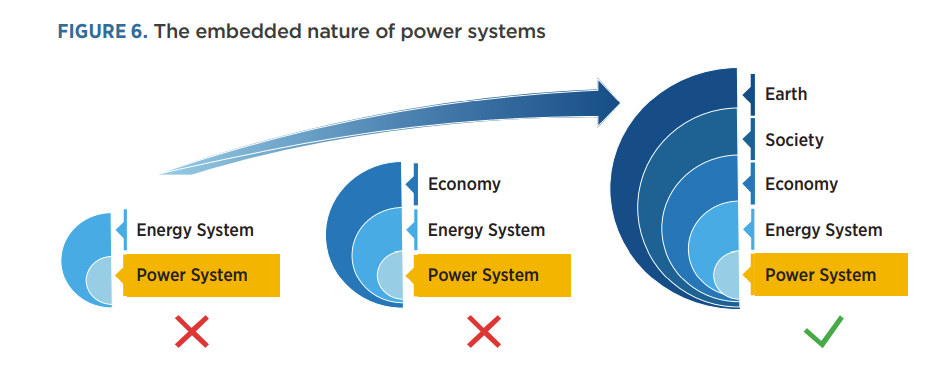
The “power system” physically entails all components related to the production, conversion, delivery and use of electricity. It is embedded in the energy system, with multiple links and feedbacks with other components of the energy system. These links and feedbacks will likely become even more prominent as the transition progresses and as the energy system is further integrated through sector coupling. The energy transition thus influences, and is influenced by, elements external to the boundaries of the energy and power systems. There is a need for a systemic approach and a holistic perspective to understand these systemic interactions. The energy transition must harness all the potential and
synergies of these interactions.
POWER SYSTEM ORGANISATIONAL STRUCTURES
When power systems were first developed, electricity was produced close to the point of demand, which was typically an industrial load. As cities were electrified, distribution grids and later transmission grids connected the urban centres with relatively distant power generators. Gradually, meshed networks with multiple generators providing electricity to various loads were developed, leading to the first national grids (Figure 7).
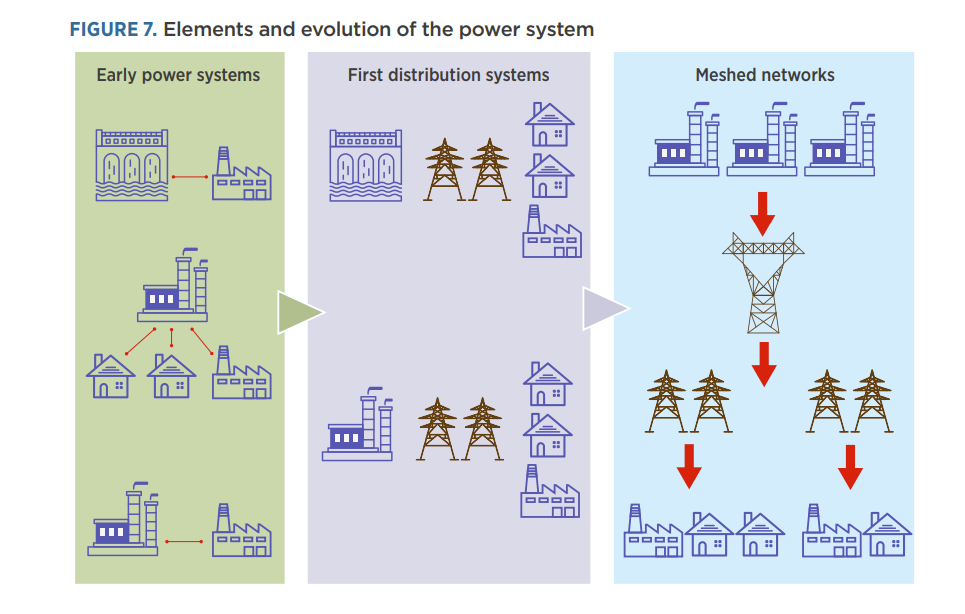
Current power system organisational structures are differentiated in multiple ways, due mainly to the context-specific historical evolution, maturity and predominance of market or regulatory paradigms. An important differentiating element is the degree of competition within the organisational structure. Whereas at the beginning of the 20th century vertically integrated regulated monopolies were commonplace, since the 1980s various elements of competition have been introduced worldwide. These range from fully unbundled and liberalised systems in both the wholesale and retail operations to power purchase agreements between a regulated utility and private companies.
THE TRANSITION’S IMPLICATIONS FOR THE POWER SYSTEM
For the energy transition to contribute to addressing climate change and sustainability challenges, a holistic approach that pays attention to all layers of the system and their interactions is needed. This chapter describes the context in which the energy transition will unfold, highlighting cross-cutting systemic dimensions, and different elements and dynamics at play. Power system organisational structures are themselves the product of the transformative processes that the wider energy and socio-economic systems have been undergoing, and of their interaction with the power system. Now, due to the urgency of facing the climate emergency, organisational structures will need to anticipate and not only adapt to the future paradigm shifts transforming societies and the Earth, so that they can help facilitate the transition.
Cross-cutting transformations for a fair and just energy transition from the power, energy, social, economic and Earth systems.
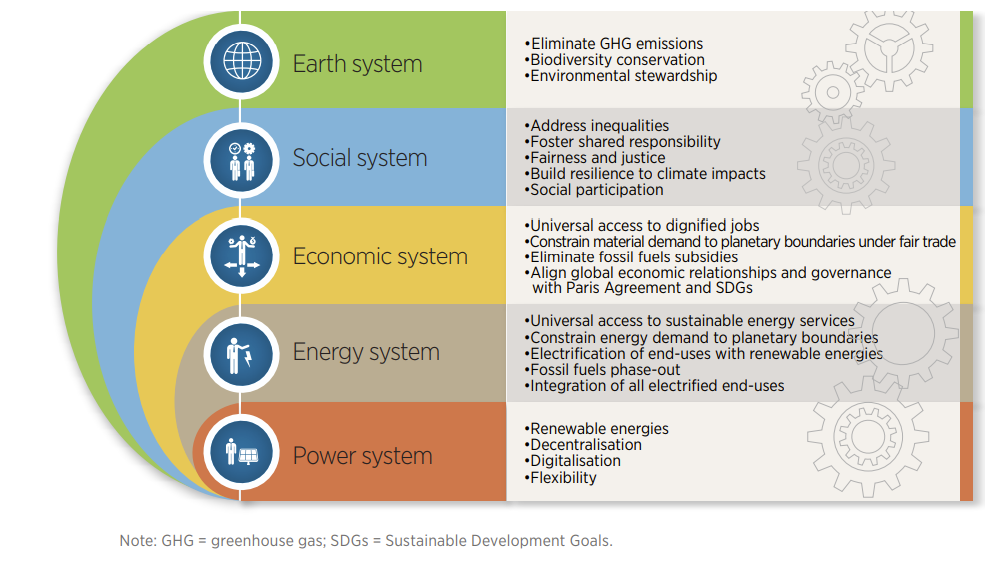
Rapid transition rates always entail socio-economic stress, especially around the (unequal) share of benefits and burdens of the transformation. Communities that are already impoverished and living in degraded ecosystems present limited resilience to further economic and ecological stress that could be locally induced by the transition, although the overall impact is expected to be positive in the long run. If not addressed, pre-existing inequalities increase the risk of social opposition to the transition or social polarisation around the transition trade-offs (NGFS, 2021). In this context, ignoring systemic interactions is not an option. A holistic approach to the energy transition can support societies to face the climate crisis while simultaneously creating better opportunities for widespread prosperity (IRENA 2020b; 2021b).
Articulating such an approach requires gaining insights about systemic interactions and developing organisational structures that address them.
CONTEXTUALISING POWER SYSTEM STRUCTURES
If one of the main goals today is to have mostly (if not entirely) renewables-based generation, then to realise the full potential and positive contribution of renewables, power system organisational structures must be tuned to the characteristics and requirements of renewable energy. Since challenges spur from differences in technological characteristics between conventional and transition-related resources, all power systems, from the more regulated to the fully liberalised, will face them. In some systems, the share of renewable energy in the power system has already grown substantially (Figure 9). Thanks to pro-active policy making, many countries have reached VRE shares up to 20%,
and examples exist of systems with high shares of VRE (above 30%) in countries or regions such as Denmark and Uruguay.

the design of these organisational structures is essential to understand what measures will be needed. The next section delves into the central aspects of power system organisational structures.
Energy authorities have been set up by countries to co-ordinate and regulate power systems, even in the more liberalised contexts. These authorities set the rules of power systems and may be energy ministries or some form of third-party entities (such as ARERA in Italy), receiving their mandate from the central government. In the case of a vertically integrated state-owned utility, the authority may be within the utility itself, which can then self-regulate in a situation of total or partial monopoly.

The goals and constraints presented in Figure 10 give shape to power system regulations. For example, technical goals may change the definition of ancillary services, while economic and social goals may change the way ancillary services are procured. Without proper regulation being implemented, bottom-line goals will not be achieved, and constraints will be transgressed, with the supply of electricity not providing social value. and practices set by the energy regulator. The energy authority sets the tariffs for all users. Users pay the regulated tariffs to the utility, which is the sole vendor of electricity. Other revenue streams fed by general taxation may complement those from regulated electricity tariffs (Figure 11).

Regulated payments for large-scale renewable energy Capital subsidies were among the first instrument selected to encourage renewable energy deployment (Figure 19). These payments lower the overall investment costs and thus make the technology competitive or even attractive compared to other options, which allows for overcoming the increased risk perception. It is a relatively straightforward mechanism; however, once granted, it does not guarantee good operational performance. Feed-in tariff schemes entail an agreed revenue per megawatt-hour produced. Feed-in tariff schemes are usually accompanied by priority of dispatch. Effectively, this means that electricity can be produced at any time of the day or year while receiving a stable payment, irrespective of the actual price of electricity or the value it brings to the power system. Under a feed-in tariff scheme, operators have to reach a minimum level of performance to repay the initial investment (the performance risk is transferred to the owners).
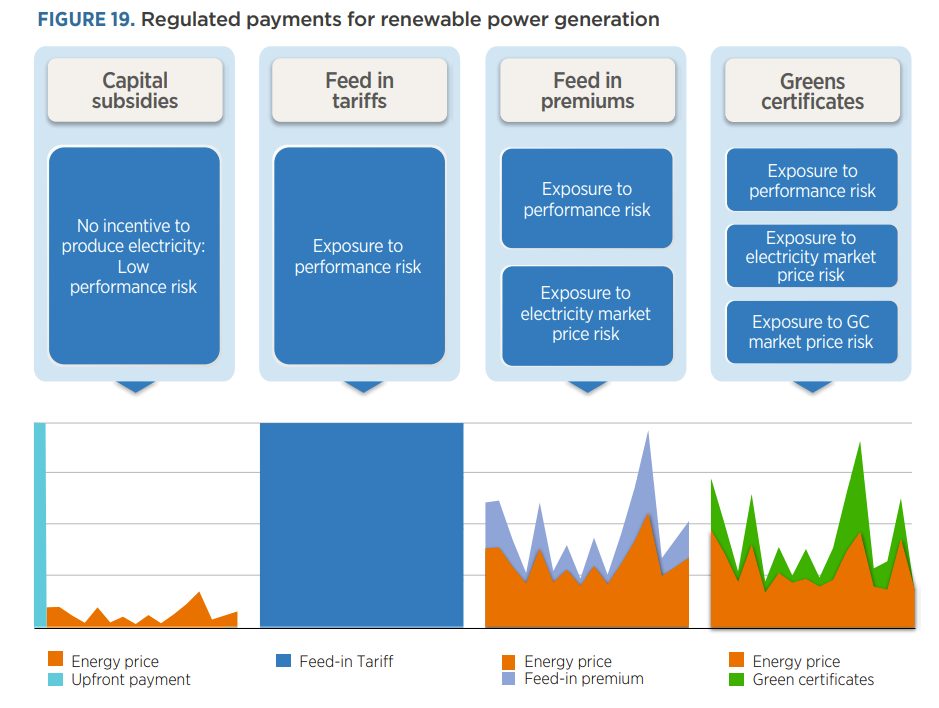
As renewable power technologies evolved further, support policies transferred the price risk to developers, who had to participate in electricity markets and would receive a feed-in premium – that is, an additional payment on top of the market price. The premium definition differs across schemes, from a fixed value to variable (also called “sliding”) premiums for each megawatt-hour sold into the market.
ENABLING THE TRANSITION OF POWER SYSTEM ORGANISATIONAL STRUCTURES
Power system organisational structures were designed with the blueprint of the fossil fuel era and had to be suited to the prevalent technologies of a centralised energy system and to the goals of the time. Governments now face a new challenge for the power sector: to successfully integrate renewable energy power plants at a rapid pace while maintaining adequate overall system costs and fostering the maximisation of both system and social value – and in a context of widespread electrification of the economy. The wholesale price reduction introduced by increasing shares of renewable technologies, whether in liberalised or regulated 23 organisational structures, is often welcomed by policy makers (since it is, in the end, a reduction in energy prices). However, these low prices and the mechanism underpinning
them introduce important transitional barriers as VRE shares increase.

Wholesale electricity markets are traditionally the main source of revenue for dispatchable generation. Price and volume depression can trigger requests and pressures to provide additional payments such as capacity payments to incumbent technologies (such as fossil gas), thus further entrenching them into the system and slowing down the transition.
The generators first and most affected by the deployment of renewables in marginal price allocation organisational structures are typically gas-fired power plants, which provide the bulk of current system flexibility. Fossil fuel-based generators have to be phased out during the transition. However, the retirement of the most flexible fossil fuel generators must not outpace the deployment of other sources of flexibility fit for a renewable-based energy system.
As self-consumption increases, for a given overall demand, less electricity has to be generated, distributed and billed by the central system, which, under prevailing tariff structures and grid remuneration mechanisms 29, results in a smaller basis for the recovery of the fixed costs of the grid. Hence electricity tariffs need to be increased, 30 starting a vicious cycle: rising electricity bills encourage more investment in self-consumption solutions such as solar PV (load defection), which cause further reductions in the volume of electricity billed, which further increase electricity tariffs, pushing for more distributed PV, and so on. This eventually leads to grid defection, 31 where the potential value from the grid would be lost. This situation is called the “grid death spiral” (Figure 25).

The grid death spiral issue goes beyond the fact of losing or not losing the potential system value of the grid for those users that defect. There is a social justice dimension attached to it. Given their capital-intensive nature, distributed renewable energy sources, such as solar PV systems, 32 have usually been adopted first by higher-income households. Vulnerable, low-income users cannot afford the initial investment, even if a tax incentive or a regulated payment scheme is in place (Barbose et al., 2018; Coffman, Allen and Wee, 2018; Gaigalis et al., 2016, Lukanov and Krieger, 2019; Macintosh and Wilkinson, 2011). Hence, the grid death spiral dynamic can exacerbate energy poverty, as the increased electricity bills burden users that are fully dependent on the grid but have not been able to invest in distributed energy
resource solutions, such as low-income users. This reduces even further their opportunity to deploy renewable energy and increases social inequalities. These social inequalities can trigger barriers to transition as a consequence of not bringing all on board by failing to address the equity dimension of the energy transition.
Between 9 March and 21 June 2020, a nation-wide lockdown was declared in response to the COVID-19 pandemic, with the stricter measures reducing economic activity and mobility enforced between 19 March and 11 May. Electricity demand dropped quickly with the confinement measures, down 15.7% on average in April 2020 compared to the previous five years. The lower electricity demand led to higher VRE shares than in former years, surpassing in several occasions the 2019 record during March and April 2020 (REE, 2022) (Figure 32).
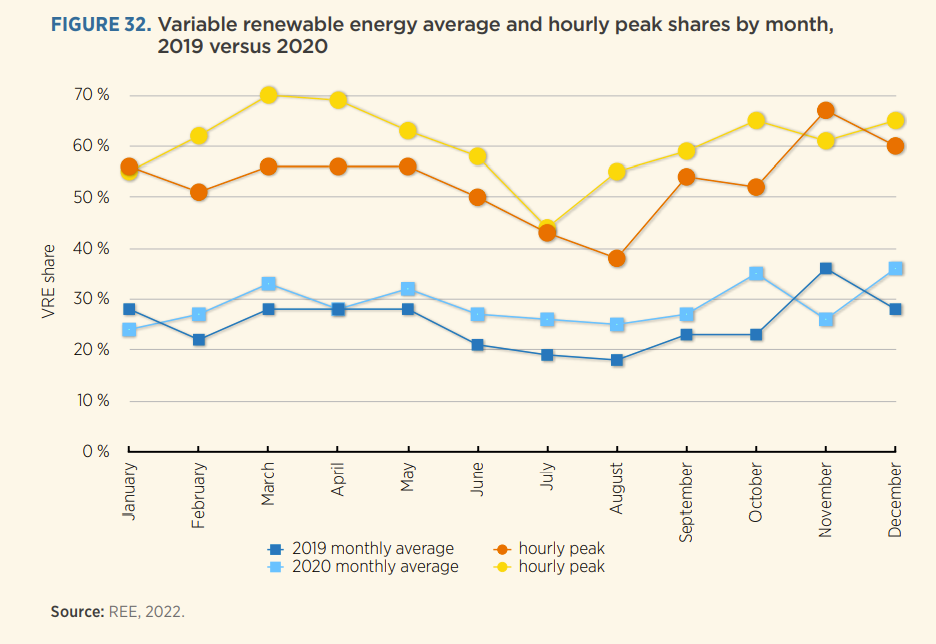
The COVID-19 induced drop in demand led to a substantial reduction in greenhouse gas emissions from the power system (-44.3% in April 2020) (REE, 2022). Despite similar shares of VRE generation that same month in 2019 (Figure 32), average monthly wholesale electricity prices also fell in April 2020 because of the higher share of hours when VRE set the marginal price during the month (Figure 31). The monthly average day-ahead clearing price in March 2020 was EUR 27.7/MWh (-27% compared to 2015-2019 average), in April was EUR 17.7/MWh (-57%) and in May was EUR 21.3/MWh (-52%) (Figure 33). Figure 35 shows the price formation curves for April 2020 at 12 p.m., when low demand and relatively large VRE generation pushed the price down to below EUR 20/MWh.

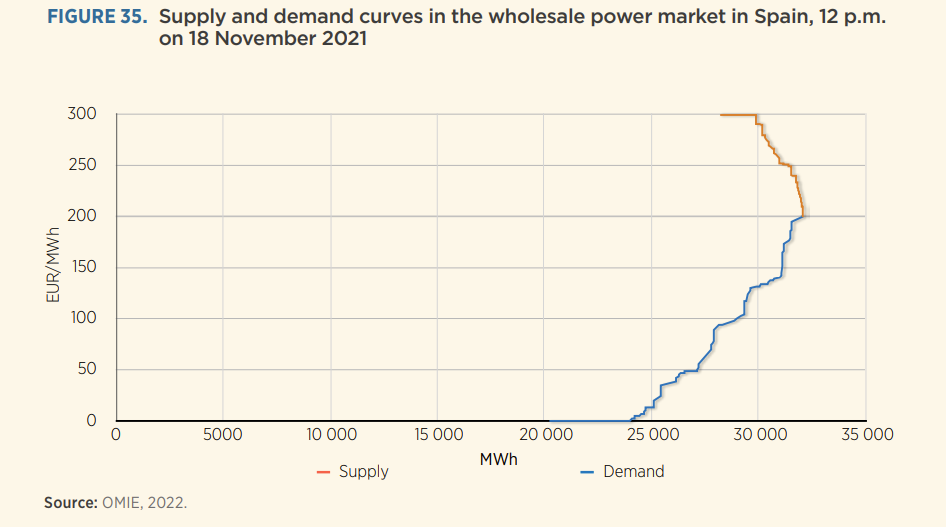
It should be noted that under the current marginal pricing structure, high wholesale clearing prices occur more often than the instances when natural gas fueled technologies directly produce these high prices by clearing the market themselves. Indeed, the high natural gas prices indirectly impact wholesale clearing prices through the bidding behavior of other dispatchable technologies, such as hydro power. Hydro power plants are very aware of the natural gas powered plant bids (often are operated by the same utility), and hence have the incentive to bid with an opportunity cost just below
the natural gas bid. Therefore, high wholesale electricity prices may also result even when natural gas plants are not the clearing technology.
PRE-TRANSITION LEARNINGS ABOUT MARKETS IN POWER SYSTEMS
The electricity sector reforms that started in the 1990s were framed under a general trend towards privatisation of the economy in the pursuit of better economic performance. Liberalisation in the power sector, as in the wider economy, was based on the idea that the combination of competition, profit maximisation and strong incentives for managerial alignment with the profit maximisation goal would improve the economic efficiency of utility operations (World Bank, 1993). At that time, many VIUs often suffered from social disaffection, as they were struggling to get rid of the burden of excessively bureaucratic management and had decision-making processes with scarce public accountability and
high vulnerability to political instability. This created a favourable environment to weaken socio-political resistance to liberalisation in the power sector and, similarly, in many other public services such as water supply, rail transport or health services. International institutions often reinforced the trend towards liberalisation, especially in developing countries, by dictating it as a pre-requisite to access international support or finance (Chang, 2010).
The privatisation dilemma is not exclusive to the power sector. Other sectors dealing with vital services have been confronted with opposing arguments regarding profit-driven organisational structures, especially when socio-economic changes are taking place (Box 21). Already more than 1 500 cases of (re)municipalisation of essential services have been mapped globally, following attempts to rebuild public capacity to provide local services as a direct response to existing challenges faced by privatised structures (Figure 39) (TNI, 2020). Motivations observed for de-privatisation measures in many sectors are diverse, but they often include reverting the inadequate performance of privatisation or the need to align the service provided with wider policy objectives (environmental, social or other).

A VISION FOR RETHINKING POWER SYSTEM ORGANISATIONAL STRUCTURES: THE DUAL PROCUREMENT MECHANISM
OVERALL VIEW
Power system organisational structures are designed around social and political goals (see chapter 3) and count on economic and physical allocation and procurement mechanisms to reach those goals, within the system’s technical limits. The way in which energy and flexibility services are rewarded brings crucial information in both the short term (“Should we provide this service now?”) and long term (“Should we invest in the system and commission a new unit?”). Organisational structures convey the signals that determine the future of the power system.
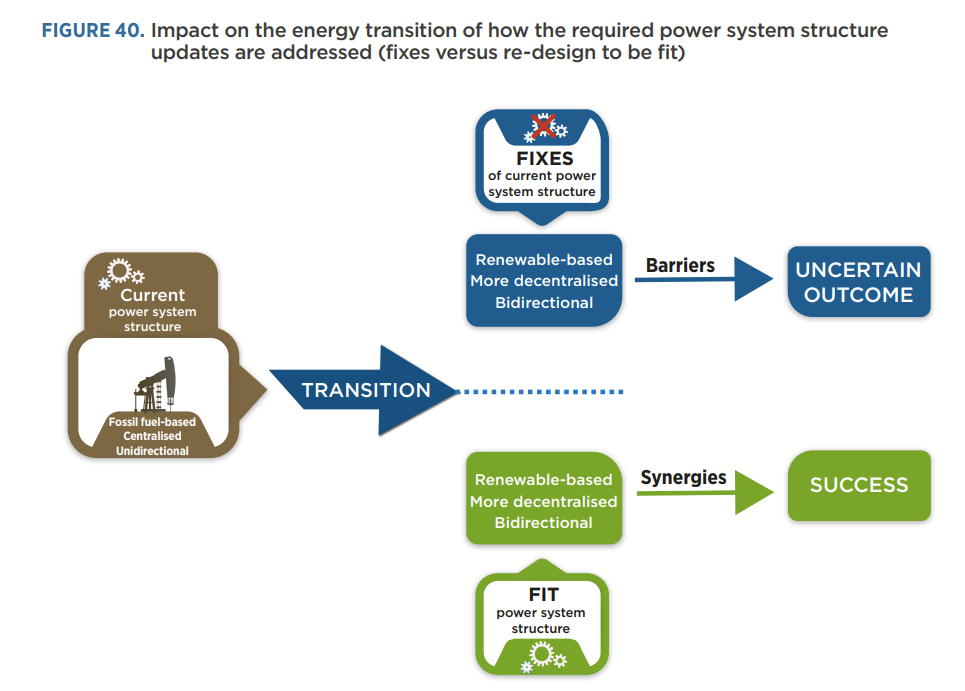
The dual procurement concept presented below addresses the underlying misalignments in power system organisational structures by acknowledging the intrinsic characteristics of renewable energy generation and flexibility supply, as well as how these interact with the socio-economic system. The aim of this chapter is for the dual procurement concept to act as a lighthouse, informing and guiding the structural evolution of both liberalised and regulated power systems towards the organisational structures of the renewable energy era. resources can be balanced at an economy-wide level to better manage the retribution of the provided social value. Besides risk allocation, an important aspect of the public ownership approach is how the direct public investment is sourced. Direct public expenditure may be financed through a loan
by public or private banks. If financed through private banks, the situation is similar to the debt and equity provision to the IPP contractor in the auctions approach pathway, and finance costs will also be similar (depending on the relative state and corporate credit ratings) since they have to produce profit for the private banking sector.

Fostering effective participation Attention should be given to reducing entry barriers for new stakeholders such as households, small and medium-sized businesses, sector coupling, municipalities, co-operatives and energy communities,
since this is a pre-condition for triggering the needed collaborative effort. In liberalised environments, effectively involving some of these actors may require articulating out-of-market elements. In regulated environments, this may require implementing adequate participation rules and facilitating infrastructure that empowers decentralised and multi-stakeholder effective and equitable interaction. The benefits from risk reduction provided by long-term regulated payments go beyond reducing the costs of electricity. Enhanced participation of households, small and medium-sized businesses, communities, energy co-operatives and municipalities, which are usually more reluctant to face risk, is an additional potential benefit.
Source:IRENA

You must be logged in to post a comment.